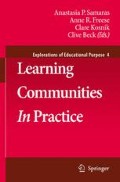Although the notion of a “community” is commonly used in current educational literature, the term is quite old. It was first mentioned by John Dewey over 110 years ago, when he envisaged that classrooms should be organised like a community rather than simply being places for the dissemination of knowledge. Dewey's theory of “learning through experience” was based on the assumption that learning involves an interaction between psychological processes focused on the individual, and sociological processes focused on how an individual interacts with others. The example he often used in describing the interaction between psychological and sociological processes was children learning to talk in the ideal community environment of an educated family.
I believe that this educational process has two sides - one psychological and one sociological; and that neither can be subordinated to the other or neglected without evil results following. Of these two sides, the psychological is the basis. The child's own instincts and powers furnish the material and give the starting point for all education. I believe that knowledge of social conditions, of the present state of civilization, is necessary in order properly to interpret the child's powers. (Dewey, 1897, pp. 4–5)
Access this chapter
Tax calculation will be finalised at checkout
Purchases are for personal use only
Preview
Unable to display preview. Download preview PDF.
References
Bereiter, C. & Scardamalia, M. (1993). Surpassing ourselves: An inquiry into the nature and implications of expertise. Chicago, IL: Open Court.
Darling-Hammond, L. (Ed.). (1994). Professional development schools: Schools for developing a profession. New York: Teachers College Press.
Dewey, J. (1897). My pedagogic creed. New York: E. L. Kellogg.
Dewey, J. (1916). Democracy and education. New York: Macmillan.
Dewey, J. (1938). Experience and education. New York: Collier Books.
Grossman, P. & Wineburg, S. (2000). What makes teacher community different from a gathering of teachers? Washington: Center for the Study of Teaching and Policy, University of Washington.
Hoban, G. (2005). From claymation to slowmation: A teaching procedure to develop students' science understandings. Teaching Science: Australian Science Teachers Journal, 51(2), 26–30.
Hoban, G. (2007). Using slowmation to engage preservice elementary teachers in understanding science content knowledge. Contemporary Issues in Technology and Teacher Education, 7(2), 1–9.
Hoban, G. (2009). Facilitating learner-generated animations with slowmation. In L. Lockyer, S. Bennett, S. Agostino, & B. Harper (Eds.), Handbook of research on learning designs and learning objects: Issues, applications and technologies (pp. 312–329). Hershey, PA: IGI Global.
Hoban, G. F. (2002). Teacher learning for educational change: A systems thinking approach. Buckingham and Philadelphia, PA: Open University Press.
Hoban, G. F. (2003). Changing the balance of a science teacher's belief system. In J. Wallace & J. J. Loughran (Eds.), Leadership in science education. London: Routledge Falmer.
Hoban, G., & Ferry, B. (2006). Teaching science concepts in higher education classes with slow motion animation (slowmation). In T. Reeves & S. Yamashita (Eds.), Proceedings of E-Learn, 2006 World conference on E-Learning in Corporate, Government, Healthcare & Higher Education (pp. 1461–1646). Assocation for Advancement in Computing in Education: Honolulu, Hawaii.
Hoban, G. F., Butler, S., & Lesslie, L. (2007). Facilitating self-study of professional development: Researching the dynamics of teacher learning. Studying Teacher Education, 3(1), 35–51.
Senge, P. (1990). The fifth discipline. New York: Doubleday.
Sweller, J. (2006). Discussion of emerging topics in cognitive load research: Using learning information characteristics in the design of powerful learning environments. Applied Cognitive Psychology, 20, 353–357.
Editor information
Editors and Affiliations
Rights and permissions
Copyright information
© 2008 Springer Science + Business Media B.V
About this chapter
Cite this chapter
Hoban, G.F. (2008). Lights, Camera, Action! Using Slowmation as a Common Teaching Approach to Promote a School Learning Community. In: Samaras, A.P., Freese, A.R., Kosnik, C., Beck, C. (eds) Learning Communities In Practice. Explorations of Educational Purpose, vol 4. Springer, Dordrecht. https://doi.org/10.1007/978-1-4020-8788-2_4
Download citation
DOI: https://doi.org/10.1007/978-1-4020-8788-2_4
Publisher Name: Springer, Dordrecht
Print ISBN: 978-1-4020-8787-5
Online ISBN: 978-1-4020-8788-2
eBook Packages: Humanities, Social Sciences and LawEducation (R0)

